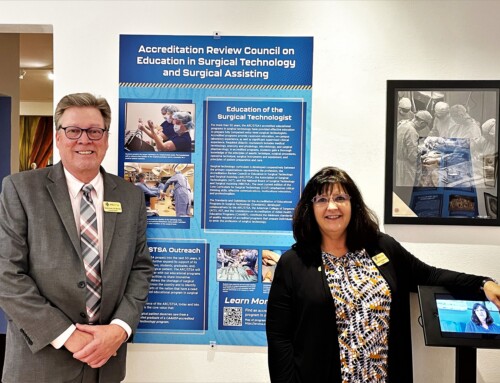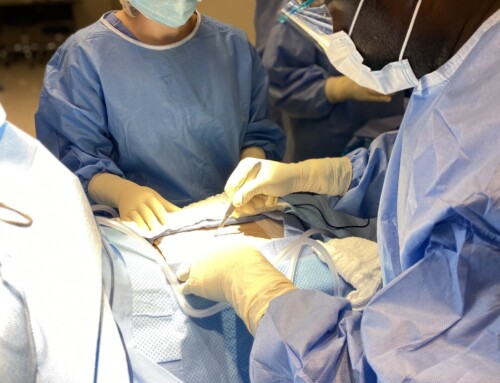An Essential Practice for Well-Rounded Education in Patient Care
Surgical technology and surgical assisting students spend countless hours studying human anatomy and the techniques and tools needed to be the best ST or SA possible. It can be easy to get lost in the technical aspects of surgery and feel isolated from a patient, as so often the surgical team is behind masks and focused intently on the task at hand. It is for this reason that students, and those in the profession generally, should look beyond the operating room for a well-rounded education in patient care.
This is where acts of community service are key. These opportunities are often local, a great way to connect with the community and a chance to serve people who may become future patients.
ARC/STSA spoke with Helga Olson, M.S., CSA, CSFA, Certified Surgical Assistant at the Mayo Clinic in Rochester, Minnesota, to learn more about the Mayo Clinic’s history of student-led service projects; and Nicole Kochan, Surgical First Assisting (SFA) student at the Mayo School of Health Sciences, who recently led a day of service at The Gift of Life Transplant House in Rochester, Minnesota.

SFA Students from the Mayo Clinic School of Health Sciences hosted a spaghetti dinner for guests at The Gift of Life Transplant House in Rochester, Minn.
Olson noted that the SFA students at the Mayo Clinic School of Health Sciences have been participating in local service projects for the past six years. “They are actively engaged, serving organizations like Habitat for Humanity, the Ronald McDonald House, the Mayo Clinic Gift of Life Transplant Center, United Way, the Veterans of Foreign Wars and more,” she said.
SFA students are encouraged to plan the experience as a group and work as a team. “While it might be a challenge to coordinate everyone’s schedules on evenings or weekends, volunteering as a class has many worthwhile benefits,” Olson added.
“When volunteering at the Gift of Life Transplant House, the patients staying [at the House] may very well be the patients they see in the operating room,” Olson said. Having the added layer of knowing who their patients are – not just medically, but emotionally – can contribute to the students becoming more empathetic in their daily work.
For guests living in these homes, it is comforting to know their medical care providers are invested in their emotional well-being. “The guests often spend a large part of their day at the Mayo Clinic going to appointments, so it is a welcome gift to return to the Gift of Life Transplant House and find a hot meal waiting for them,” Olson explained.
“Students build a sense of satisfaction when they see their volunteering efforts are helping others. [They] are far more likely to remain engaged when they can see their participation effects change,” Olson noted.
Kochan recently helped lead a spaghetti dinner at the Gift of Life Transplant House. After learning about the history of the house and the critical role it plays in the lives of so many, she knew she wanted to organize a dinner with fellow students. The group prepared and served the meal, and stayed for cleanup. For Kochan, the act of sharing a meal was most memorable. “We were able to partake in the meal, enjoy sharing stories, and hear their journeys,” she recalled. “I could tell the meal meant the world to them.”
Service projects like these are symbiotic. Olson sees community service as an opportunity for the students to grow personally and professionally. “Students build a sense of satisfaction when they see their volunteering efforts are helping others. [They] are far more likely to remain engaged when they can see their participation effects change,” she noted. “This helps them realize they are able to make useful contributions to society through service and social action. It teaches them more about themselves and that they are able to work as a team.” For those new to the area especially, Olson added, this is a chance to gain a sense of connection to their community.
The benefits of local community service are noteworthy and can be evidenced throughout the student ’s career. “As students feel a stronger sense of community, they become more effective in their academic programs and interactions with each other,” noted Ron Kruzel, ARC/STSA Executive Director. “This goes back to the heart of what ARC/STSA encourages its programs to offer – training and experiences that provide a well-rounded education, which ultimately produces better surgical technologists and surgical assistants. These opportunities allow students to become skilled communicators, more empathetic, and gain a better understanding of the emotional subtleties of patient care, which can often be lost in surgery.”
At the end of the day, these acts of service are more than a hot meal or helping hand – they are a link that fortifies the community and fulfills people on a deeper level. “The heart of a volunteer is not measured in size, but by the depth of the commitment to make a difference in the lives of others,” said Olson.
Are you or your students actively engaged in your local community? We want to hear from you. Please send your stories to the ARC/STSA Director of Education Services, Christy Baily-Byers, at christy.bailybyers@arcstsa.net.



